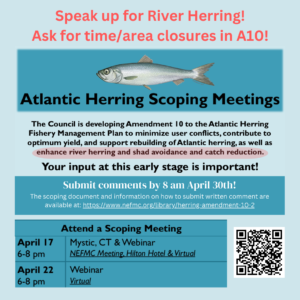What you need to know and how you can help.
Send a letter
Comments can be sent to the New England Fisheries Management Council (NEFMC) via email at comments@nefmc.org or by mail addressed to Cate O’Keefe, PhD, Executive Director, New England Fishery Management Council, 50 Water Street, Mill #2, Newburyport, MA 01950. Please note on your correspondence; “Atlantic Herring Amendment 10 Scoping Comments.” Comments must be received or postmarked by 8 am, April 30th.
Tell the NEFMC that you support measures designed to end the by-catch of river herring. In particular, time/area closures for locations where Atlantic herring fisheries overlap with concentrations of shad and river herring in waters adjacent to Southern New England.
Read the comments of Rivers Alliance
Attend a meeting
Attend a public hearing at the Hilton Hotel in Mystic on April 17 from 6:00pm – 8:00 pm. Concerned citizens can attend and speak. There will also be an online option. Register to participate online. Call in info: +1 (562) 247-8321; Access Code: 124-483-408
Attend a webinar on Webinar Monday, April 22, 2024 6:00 p.m. – 8:00 p.m. Register to participate.
New England Fishery Management Council amendment 10 information page.
Background information
Credit: Steve Gephardt
There was a time when the Connecticut River and all the State’s rivers that flow into the Long Island Sound teemed with migratory fish, including salmon, shad, striped bass, sturgeon, and river herring. The construction of dams from the late 1600s to the mid-1900s blocked their path and prevented them from spawning. The numbers of these fish plummeted. For the past 50 years we have made gains in bringing back these fish runs by cleaning up our rivers, removing unneeded dams, and building fishways around dams that remain.
Despite the earlier historical decline, Connecticut streams were still full of spawning river herring each spring as recently as the 1970s. River herring include two species, the alewife and the blueback herring, which are similar foot-long silvery fish that enter our streams in schools. Streams like the Farmington, Mattabesset and Salmon rivers; Pewterpot, Salmon, Porter, and Roaring brooks and Chester and Higganum creeks were full of spawning herring up to the first dam. This was also true along the shoreline from Greenwich to Groton; every sizeable stream had river herring runs.
Stream conditions are now much better than they were in the 1970s yet the numbers of river herring have been in a downward spiral since then and are now at risk. Numbers lifted over the Holyoke Dam went from 630,000 to 21. Most of the small streams flowing into the Connecticut River are empty. The blueback herring are more-or-less extinct from smaller coastal streams.
How can this be?
About the time when the decline began, large trawlers started harvesting Atlantic herring from the waters off the eastern end of Long Island Sound during the late winter when our river herring were congregating to enter the Sound for their spring spawning runs. Atlantic herring and river herring are closely related and resemble each other. The massive nets, often pulled by two huge ships, scoop up river herring along with the Atlantic herring.
After years of urging by conservationists, the New England Fishery Management Council (NEFMC) amended its Atlantic Herring Management Plan by prohibiting trawlers in the area of the ocean off southern New England waters when our river herring are mixing in with the Atlantic herring. However, the courts threw out the closure on a procedural issue before we could see any gains. The trawlers have now returned and continue to kill our river herring.
Why do we care about river herring? They are the forage base supporting both freshwater and saltwater ecosystems. Everything eats them including ospreys, bald eagles, striped bass, tuna, largemouth bass, and great blue herons. If we care about our rivers and the Sound, we need to have an abundance of these fish, yet we have a history of treating forage fish as expendable.
Rebuilding river herring runs will revitalize our waters, support all manner of wildlife, and improve recreational fishing, which is a lucrative industry supporting tourism and contributing to our quality of life. It has been said that there are plenty of river herring in Maine so there is no need for concern. That’s because the NEFMC closed their coastal waters to the trawlers. Now the trawlers come to southern New England to catch our fish because the NEFMC has not closed our coastal waters.
Is that fair?
It is time that NEFMC provides the same protection for our fish that it provides Maine. The NEFMC is considering a number of protective measures including re-closing the Southern New England area via a proposed amendment to the Atlantic Herring Plan called Amendment 10.
The people of Connecticut and the Connecticut River watershed need to speak up and demand fair treatment.
